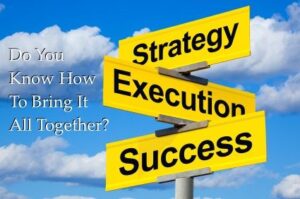Strategy is, and should be, simple. It consists of 3 dimensions:
1. Value Proposition: what your company does excellently, better than your competitors, that brings customers to your door
2. Value Chain: all of the tasks and work your people do in order to deliver your value proposition
3. Fit: how well you’ve aligned your people, processes, priorities, etc. with your value proposition

Seasoned CEOs and leadership teams tend to be good at developing strategy, which is where your competitive advantage is born. Effective execution puts legs on your value proposition. Without execution, your strategy and your competitive advantage are sunk.
Effective execution retains customers. It’s where your value proposition thrives. It builds your brand. And, it opens the door to success.
A recent article in Manufacturing.net, “U.S. Vehicle Recalls Hit 9 Year High In 2013″ demonstrates that collectively, several automakers, including Toyota, who has been touted as a model for producing quality for decades, unleashed 9% more poor quality on their customers, recalling 21.9 million vehicles via 632 recalls in 2013.
Fortune magazine, well known for its business insights, printed an article in 1999 called “Why CEOs Fail”, highlighting an important fact: 70% of CEO failures were caused by poor execution against the business strategy. Forbes magazine printed an update to that article on March 22, 2012, reaffirming this unfortunate statistic is still true today. Forbes listed examples of expedited CEO departures from companies such as BP, Hewlett-Packard, Bank of New York Mellon and Yahoo.
These companies had strong visions, business strategies and plans. So, these failures were not the result of poor business strategy. The challenge we face in today’s businesses continues to be in execution.
What causes organizations to miss the bar in execution, and how can current leaders drive improvement in execution? To answer this key question, we’ll describe 5 keys to effective strategy execution.
1. Strategic Understanding
How well does each member of your workforce understand who your competitors are, how they differ, and what it is that your business delivers that differentiates you from the competition? Can each employee relate his/her role, skills and daily performance to delivery of your company’s unique, differentiating value? Is this a regular topic of discussion at work? From the production floor to customer service, to product design, purchasing and supplier effectiveness – all of the decisions made by employees throughout your value chain — is there an ever-present understanding and focus on your company’s value proposition?
2. Leadership
Do your organization’s executives and managers have high credibility with the workforce? How effectively do they lead and support people through necessary change to build the Fit between your value proposition and your value chain? What are the creative, compelling communications your leaders provide daily to enable people to maintain their focus and to make decisions aligned with your strategy? What level of involvement do employees have in anticipating and solving problems that impact strategic performance?
3. Balanced Metrics
What are the metrics used to measure and monitor your organization’s performance? Are they aligned with your strategy, guiding decision making and prioritization? Is there a blend of financial (lagging) indicators and non-financial (leading) indicators? Do people use the leading indicators to spot problems or obstacles early and implement solutions? How often is performance on metrics reviewed and discussed, throughout your organization?
4. Activities and Structure
Has your organization evaluated its processes, procedures, policies, budget, and organization structure, to identify ways to tighten alignment with the strategy? Doing this effectively helps to remove obstacles to getting work done, and helps to standardize and automate the tasks required to deliver your promised, unique differentiating value to the customer. Frequently, initiatives, such as those for standardization or efficiency, have purposes and objectives that can conflict with and impede strategic performance. This is often the case when an organization implements generic Best Practices. Have your functional initiatives been aligned to fit the strategy of your company?
5. Human Capital
One glance at a Standard & Poors chart tells a story all leaders need to know: the value of intangible and tangible assets has actually made a complete reversal in recent decades. Where in the past investors looked primarily at a company’s tangible assets such as bricks and mortar, machinery and equipment, to determine the value of a business — investors now look almost exclusively at the intangible assets such as intellectual capital, leadership credibility, brand, strategic relationships, execution capability and human capital. People are now the primary value. Is your organization effectively investing in and leveraging the value of its people? Is training aligned with the strategy? Are new hires selected based on criteria that include ability to add strategic value? Are employees placed in positions using their preferred skills and offering growth and autonomy? Is the culture one of compliance in a command-control environment, or one of commitment in an environment of inclusion?
There is an excellent article in Industry Week, “Improve People First” by Karyn Ross, that is a must-read for manufacturing leaders who want to achieve new heights in organizational performance. If problem solving or prevention is a key to eliminating quality issues, your on-the-job training, job descriptions and work procedures need to include these skills and steps. If quality is part of your value proposition then training and empowerment in making quality pass/fail decisions is critical for execution and needs to be included in job design and among individual goals. If manufacturing managers need to standardize parts while ensuring quality for the customer as part of your value proposition, this too needs to aligned and kept front and foremost. Alignment is simple but not easy.
Focus on the 5 components above to strengthen your organization’s execution. Master the details in these basics, and you’ll make a difference.
Please share your company’s practices as they relate to these questions. What obstacles are you facing in strategy execution?
